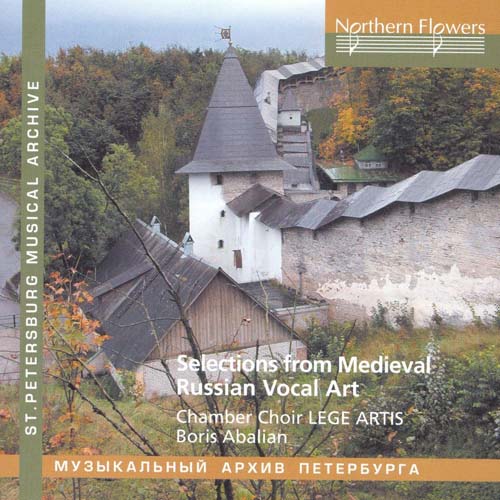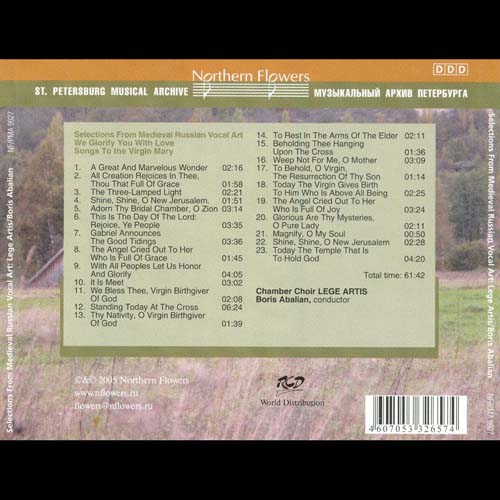Description
Selections from Medieval Russian Vocal Art
We Glorify You with Love
Songs to the Virgin Mary
LEGE ARTIS Chamber Choir Boris Abalian, conductor Recorded in Veliky Novgorod, Znamenny Church, November 16-18, 2001
Sound recording and supervision: Sergey Sokolov
English text: Sergey Suslov
Design: Anastassia Evmenova & Oleg Fakhrutdinov
|
1. |
A GREAT AND MARVELOUS WONDER…16-voice partesny (part-singing) concerto on the text of a vesper stichera from the Nativity of Christ |
2:16 |
|
2. |
ALL CREATION REJOICES IN THEE, THOU THAT FULL OF GRACE… Hymn to the Birthgiver of God from the Liturgy of St. Basil the Great, Greek chant |
1:58 |
|
3. |
THE THREE-LAMPED LIGHT… Vesper stichera from the Entry to the Temple, partesny arrangement of znamenny chant |
2:21 |
|
4. |
SHINE, SHINE, O NEW JERUSALEM… Hymn to the Birthgiver of God from the Paschal service, putevoy chant |
1:51 |
|
5. |
ADORN THY BRIDAL CHAMBER, O ZION… Vesper stichera from the Meeting of Our Lord, znamenny chant |
3:14 |
|
6. |
THIS IS THE DAY OF THE LORD: REJOICE, YE PEOPLE… Vesper stichera from the Nativity of the Birthgiver of God, partesny arrangement of znamenny chant |
3:35 |
|
7. |
GABRIEL ANNOUNCES THE GOOD TIDINGS… Matins stichera from the Annunciation, demestvenny chant |
3:36 |
|
8. |
THE ANGEL CRIED OUT TO HER WHO IS FULL OF GRACE…Refrain before the ninth ode of the Paschal canon, polyphonic demestvenny line-song |
1:45 |
|
9. |
WITH ALL PEOPLES LET US HONOR AND GLORIFY… Hymn to the Birthgiver of God from the Lazarus Saturday service, sredny chant |
4:05 |
|
10. |
IT IS MEET…Hymn to the Birthgiver of God from the Liturgy of St. John Chrysostom, polyphonic znamenny line-song |
3:02 |
|
11. |
WE BLESS THEE, VIRGIN BIRTHGIVER OF GOD…Matins stichera from the Feast of St. Michael the Archangel, Bulgarian chant |
2:08 |
|
12. |
STANDING TODAY AT THE CROSS…Lament of the Birthgiver of God, spiritual song |
6:24 |
|
13. |
THY NATIVITY, O VIRGIN BIRTHGIVER OF GOD…Troparion of the Nativity of the Birthgiver of God, znamenny chant |
1:39 |
|
14. |
TO REST IN THE ARMS OF THE ELDER…Matins stichera from the Meeting of Our Lord, polyphonic strochny line-song |
2:11 |
|
15. |
BEHOLDING THEE HANGING UPON THE CROSS…Stichera to the Birthgiver of God, standing at the Cross, znamenny chant |
1:36 |
|
16. |
16. WEEP NOT FOR ME, O MOTHER… Hymn to the Birthgiver of God from the Holy Saturday service, putevoy chant |
3:09 |
|
17. |
17. TO BEHOLD, O VIRGIN, THE RESURRACTION OF THY SON. Concluding refrain for the recitation of Ps.118 at Holy Saturday matins, znamenny chant |
1:14 |
|
18. |
TODAY THE VIRGIN GIVES BIRTH TO HIM WHO IS ABOVE ALL BEING… Kontakion of the Nativity of Christ, polyphonic znamenny line-song |
2:25 |
|
19. |
THE ANGEL CRIED OUT TO HER WHO IS FULL OF JOY…Refrain before the ninth ode of the Paschal canon, Bulgarian chant |
3:24 |
|
20. |
GLORIOUS ARE THY MYSTERIES, O PURE LADY… Vesper stichera from the Dormition, south Russian variant of the znamenny chant |
2:11 |
|
21. |
MAGNIFY, O MY SOUL… Magnification for the Dormition, partesny arrangement of Greek chant |
0:50 |
|
22. |
SHINE, SHINE, O NEW JERUSALEM… Hymn to the Birthgiver of God from the Paschal service, partesny arrangement of Greek chant |
2:28 |
|
23. |
TODAY THE TEMPLE THAT IS TO HOLD GOD…12-voice partesny concerto on the text of a matins stichera from the Entry into the Temple |
4:20 |
|
Total Time |
61:42 |
|
From the History of Old Russian Chants
|
|
The legend of adoption of Christianity in Russia as stated in the Chronicle of Years and Times has it that the unprecedented beauty of divine service was the main reason for choosing the Byzantine model of Christian faith. Church singing heard by Prince Vladimir’s ambassadors in Constantinople amazed them with its delightful beauty. The Byzantine aesthetics inheriting the Platonic doctrine of identity of beauty, truth, and deity proved to be very close to the heart of ancient Slavs, and had a tremendous impact on generation of a new professional singing culture in Russia.
|
|
Znamenny chant, a greatest achievement of medieval culture, was the core chant in singers’ repertoire over the whole history of sacred singing in Ancient Russia. New styles of singing, Putevoy and Demestvenny chants, appear in the second half of the 15th century. The Putevoy chant competed with the Znamenny in popularity, and was a nationwide model along with it. The demestvenny chant is one of the most beautiful melismatic chants in the vocal heritage of Old Russia.
|
|
In the second half of the 17th century, Russia’s vocal culture was enhanced with Bulgarian and Greek chants imported by Ukrainian singers. Emperor Peter the Great was a great devotee of Greek singing. At the same time, psalmas (fm. Polish psalm) appear in Russian lands under the influence of “book songs” translated from Polish. Psalmas, or sacred songs, were written to religious texts and performed in family circles in hours of leisure, instead of a worldly song.
|
|
Another impressive branch of the ancient Russian art of singing is professional polyphony. The sound of early Russian polyphonic chants is unusual for today’s audience. Their line compositions are based on a protracted putevoy chant “braided” with background voices. Added to demestvenny polyphony was a striking, rhythmically active “demestvo” part. Russian Tsar Alexey Mikhailovich, father of Peter the Great, was taught line singing as a child, and afterwards collected a remarkable music library.
|
|
However, as early as in the reign of Alexey Mikhailovich, the line singing was challenged by a kind of polyphony based on the harmonic and scale principles of Western European music. It was Partesny singing (fm. Latin partes, a choral part), the advent of which is related to the name of Patriarch Nikon. As soon as in the last quarter of the 17th century, the partes starts its solemn march across Russian lands. Under its influence, the znamenny polyphony was developed to combine the new and the old, i.e. the harmony and the linearity of melodic thinking.
|
|
The glorious climax of the partesny concerto in the first half of the 18th century was embodied in festive multichoral concertos. Under the influence of Polish masters who had adapted the traditions of the Venetian school of choral music making, a special concerto style was established in Russia. Twelve-voice compositions were the most typical for Russian choral concertos, but during the reign of Catherine the Great, the number of parts could be as high as 48. Russian partesny concertos were written without involving any instrumental ensembles, therefore the composers sought to diversify the sound of the chorus. The #147;affectation” art justified striking contrasts. The concertos colorfully match massive tutti choruses and smaller ensembles, they use sounding in different registers and techniques of instrument sound imitation are used. The focus on decorative and ornamental melodic contents, and on kaleidoscopic arrays of effective musical material creates a wonderful festive mood.
|
|
Partesny concertos have reflected all the freshness, secular attitude, and energy of the young Russian Baroque art, which came to replace the ancient “angelic” singing sanctified by centuries.
|
|
Ekaterina Arkhimandritova
|






